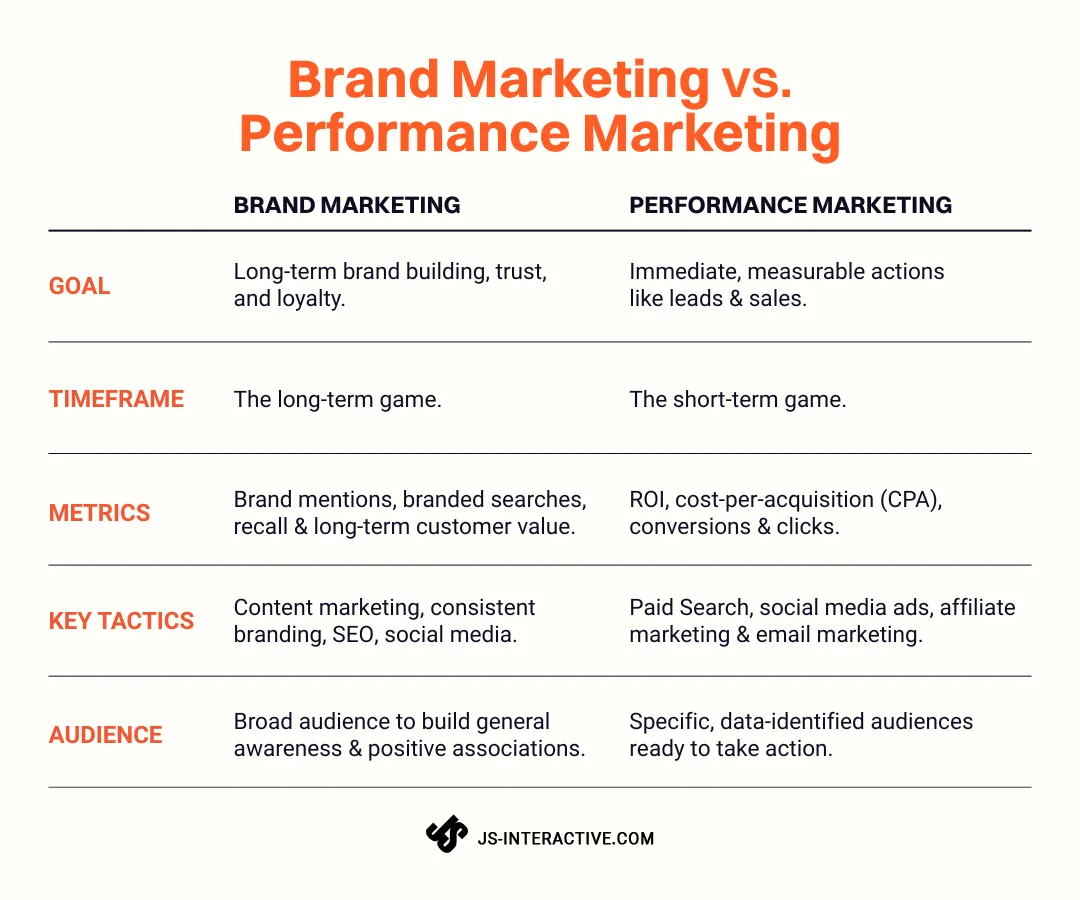5 Ways to Rethink Brand Marketing for Authentic Impact

Many teams run strong campaigns and still struggle to create real recognition.
Ads bring in traffic. Reports show solid engagement. Conversions look steady. On the surface, everything points in the right direction. Yet the brand never becomes familiar. People respond once, then disappear. The activity is there, but the connection is not.
This is where performance marketing reaches its limit. It can drive action, but it cannot build the memory or trust that keeps people coming back.
Think ‘Nike’ … or ‘Under Armour’.
Brands that last earn recognition long before the sale. They show up consistently, communicate clearly, and give people reasons to trust them.
To understand how brand and performance work together, it’s essential to know what each one means.
What Is Brand Marketing vs Performance Marketing?
Brand marketing builds familiarity and trust. It shapes how people see you and what they remember when your name comes up. Over time, this creates brand equity, which is the value of being recognized, trusted, and chosen without constant promotion.
Performance marketing drives action. It focuses on clicks, signups, purchases, and the measurable results you can track right away. It is built for immediate movement, not long-term memory.
One creates equity. The other activates it.
When people already know you, performance works faster and costs less. When they do not, performance has to work harder to get a single response.
Strong marketing relies on both. Branding builds recognition, making campaigns more effective. Performance turns that recognition into results you can see.

When Performance Becomes the Only Focus
It’s easy for teams to get hung up on performance.
Performance metrics feel clear, measurable, and immediate. ROI looks strong, dashboards stay active, and short-term KPIs create the impression that progress is steady.
The challenge? These numbers only reflect activity, not recognition. Without brand recognition, immediate results may look good in the moment; however, in the long run, they fade quickly.
Performance eventually reaches a point where it cannot deliver more, no matter how much budget you add. Paid campaigns level off, while acquisition costs may rise because people do not yet recognize or trust the brand.
You can see the shift in a few places:
- Branded searches stop growing
- Direct visits flatten or decline
- Paid campaigns become more expensive
- Customers convert once but do not return
- Churn rises because nothing keeps people connected
These are all signs that performance is trying to carry the entire load. Performance only scales when brand equity provides a foundation.
When brand marketing is part of the plan, trust can be built over time, and the business doesn’t have to purchase every interaction.
5 Ways to Rethink Brand Marketing for Genuine Impact
Brand marketing works when it helps people understand who you are and why they should trust you. It is not about volume or polished slogans. It is about clarity, consistency, and proof.
These five approaches help brands build equity in ways performance alone cannot.
1. Clarify Your Message and Keep It Consistent
Every brand needs a message people can understand quickly. Clear language about what you do and who you serve removes guesswork and makes it easier for people to move forward.
Once this message is set, consistency is what helps it stick. When your website, social content, ads, and offline materials all reflect the same core ideas, people know what to expect from you. When the message changes from place to place, it creates unnecessary friction.
A steady, aligned message creates a smoother experience and gives people a reason to pay attention.
2. Lead with Expertise, Not Promotion
People pay attention when they feel they are learning something useful. Sharing the insights, experiences, and lessons you have gained from real work shows that you know your field. It gives people a clearer sense of how you think and why your approach works.
Promotion can get attention for a moment, but expertise holds it. When you focus on teaching, explaining, or breaking down what you have seen firsthand, your content becomes more valuable. It gives people a reason to trust your perspective before they ever reach out.
Practical knowledge builds interest. Repeating sales points does not.
3. Let Customers Tell the Story
People trust the experiences of customers more than any claim a brand makes about itself.
Testimonials, reviews, and case studies give your marketing something objective to stand on. They show how your work performs in real situations.
When you highlight real outcomes instead of slogans, the message feels more credible. Prospects can see themselves in the stories and understand what working with you actually looks like.
Customer voices carry weight because they reflect lived experience. They reinforce your claims in a way promotion cannot match.
4. Build Presence Through Credibility
Visibility means more when it comes from reliable places. Mentions in respected publications, industry directories, or established communities help people see your brand as legitimate. These sources act as third-party validation, which makes your marketing easier to trust.
Partnerships and collaborations work the same way. When you align with organizations or voices that already have credibility, their audience sees you through that lens. It broadens your reach without relying on constant promotion.
Credibility compounds over time. Every mention or partnership strengthens the foundation for your marketing efforts.
5. Measure What People Remember
Brand strength shows up in the signals that reflect genuine interest, not just one-time clicks.
These are the indicators that people recognize you, look for you, and return without prompting. They reveal how well your message is sticking over time.
You can see this in metrics like:
- Growth in branded search
- More direct visits
- Increasing return traffic
- Higher engagement on content people save, revisit, or share
These patterns show that your brand is building memory, not just reach.
Sentiment and recall add another layer. Sentiment reflects how people talk about your brand and the feelings they associate with it. Recall shows whether people can bring your name to mind when they need what you offer. Both give context that raw reach cannot. Reach tells you who saw the message. Sentiment and recall tell you whether the message meant anything.
Brand metrics move more slowly than performance metrics, but they reveal the long-term impact that drives loyalty.
The New Balance: Brand First, Performance Second
Performance delivers more when people already know and trust your brand. With that foundation in place, campaigns convert faster, cost less, and create steadier growth.
Brand sets the stage. Performance builds on it.
This balance gives you marketing that lasts. It strengthens recognition, supports conversion, and makes every tactic more effective.
JS Interactive helps businesses develop strategies that connect what people remember with what drives real results. If you’d like to learn more, contact us today.